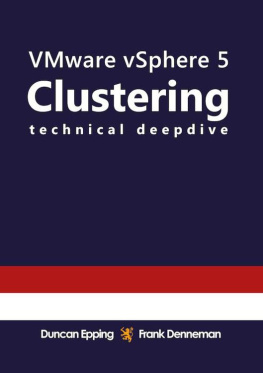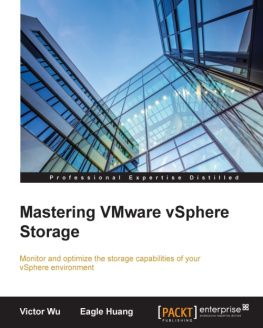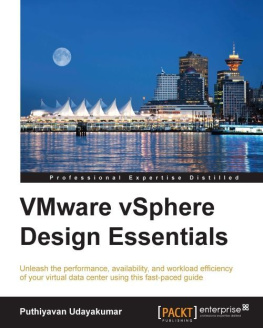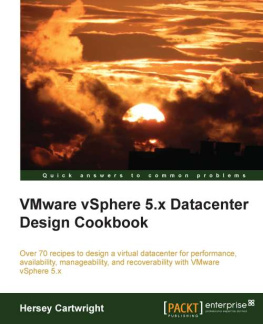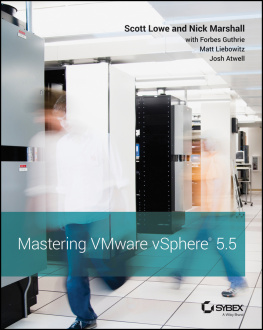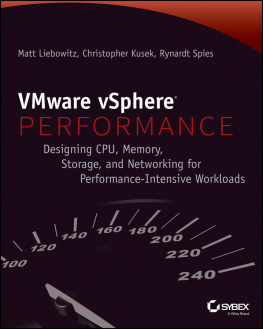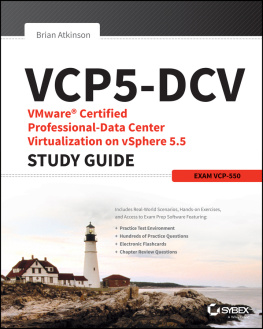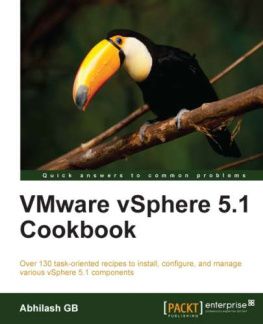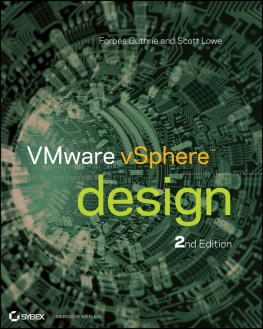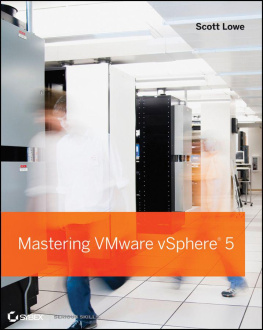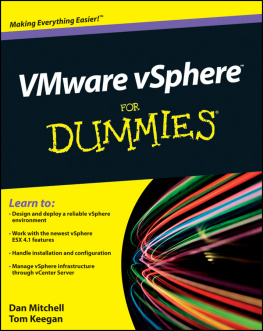Frank Denneman - VMware vSphere 5 Clustering Technical Deepdive
Here you can read online Frank Denneman - VMware vSphere 5 Clustering Technical Deepdive full text of the book (entire story) in english for free. Download pdf and epub, get meaning, cover and reviews about this ebook. year: 2011, publisher: CreateSpace, genre: Romance novel. Description of the work, (preface) as well as reviews are available. Best literature library LitArk.com created for fans of good reading and offers a wide selection of genres:
Romance novel
Science fiction
Adventure
Detective
Science
History
Home and family
Prose
Art
Politics
Computer
Non-fiction
Religion
Business
Children
Humor
Choose a favorite category and find really read worthwhile books. Enjoy immersion in the world of imagination, feel the emotions of the characters or learn something new for yourself, make an fascinating discovery.
- Book:VMware vSphere 5 Clustering Technical Deepdive
- Author:
- Publisher:CreateSpace
- Genre:
- Year:2011
- Rating:4 / 5
- Favourites:Add to favourites
- Your mark:
- 80
- 1
- 2
- 3
- 4
- 5
VMware vSphere 5 Clustering Technical Deepdive: summary, description and annotation
We offer to read an annotation, description, summary or preface (depends on what the author of the book "VMware vSphere 5 Clustering Technical Deepdive" wrote himself). If you haven't found the necessary information about the book — write in the comments, we will try to find it.
VMware vSphere 5 Clustering Technical Deepdive — read online for free the complete book (whole text) full work
Below is the text of the book, divided by pages. System saving the place of the last page read, allows you to conveniently read the book "VMware vSphere 5 Clustering Technical Deepdive" online for free, without having to search again every time where you left off. Put a bookmark, and you can go to the page where you finished reading at any time.
Font size:
Interval:
Bookmark:
VMware vSphere 5.0
Clustering
Technical Deepdive
VMware vSphere 5.0 Clustering Technical Deepdive
Copyright 2011 by Duncan Epping and Frank Denneman.
All rights reserved. No part of this book shall be reproduced, stored in a retrieval system, or transmitted by any means, electronic, mechanical, or otherwise, without written permission from the publisher. No patent liability is assumed with respect to the use of the information contained herein. Although every precaution has been taken in the preparation of this book, the publisher and authors assume no responsibility for errors or omissions. Neither is any liability assumed for damages resulting from the use of the information contained herein.
All terms mentioned in this book that are known to be trademarks or service marks have been appropriately capitalized.
Use of a term in this book should not be regarded as affecting the validity of any trademark or service mark.
Version: 1.0
About the Authors
Duncan Epping is a Principal Architect working for VMware as part of Technical Marketing. Duncan specializes in vSphere HA, Storage DRS, Storage I/O Control and vSphere Architecture. Duncan was among the first VMware Certified Design Experts (VCDX 007). Duncan is the owner of Yellow-Bricks.com, one of the leading VMware/virtualization blogs worldwide (Voted number 1 virtualization blog for the 4th consecutive time on vsphere-land.com.) and lead-author of the "vSphere Quick Start Guide" and co-author of "Foundation for Cloud Computing with VMware vSphere 4", Cloud Computing with VMware vCloud Director and VMware vSphere 4.1 HA and DRS technical deepdive. He can be followed on twitter at http://twitter.com/DuncanYB .
Frank Denneman is a Consulting Architect working for VMware as part of the Professional Services Organization. Frank works primarily with large Enterprise customers and Service Providers. He is focused on designing large vSphere Infrastructures and specializes in Resource Management, vSphere DRS and storage. Frank is among the first VMware Certified Design Experts (VCDX 029). Frank is the owner of FrankDenneman.nl which has recently been voted number 6 worldwide on vsphere-land.com and co-author of VMware vSphere 4.1 HA and DRS technical deepdive. He can be followed on twitter at http://twitter.com/FrankDenneman .
Table of Contents
Introduction to vSphere High Availability
Components of High Availability
Fundamental Concepts
Restarting Virtual Machines
Adding Resiliency to HA (Network Redundancy)
Admission Control
VM and Application Monitoring
Advanced Options
Summarizing
Introduction to vSphere DRS
vMotion and EVC
DRS Resource Entitlement
Resource Pools and Controls
Calculating DRS Recommendations
Guiding DRS Recommendations
Introduction to DPM
Calculating DPM Recommendations
Guiding DPM Recommendations
Summarizing
Introduction to vSphere Storage DRS
Datastore Clusters
Datastore Cluster Settings
Storage vMotion and SIOC
Calculating SDRS Recommendations
Guiding SDRS Recommendations
Summarizing
Integration
AcknowledgementsThe authors of this book work for VMware. The opinions expressed here are the authors personal opinions. Content published was not approved in advance by VMware and does not necessarily reflect the views and opinions of VMware. This is the authors book, not a VMware book.
First of all we would like to thank our VMware management team (Charu Chaubal, Kaushik Banerjee, Neil ODonoghue and Bogomil Balkansky) for supporting us on this and other projects.
A special thanks goes out to our technical reviewers and editors: Doug Baer, Keith Farkas and Elisha Ziskind(HA Engineering), Anne Holler, Irfan Ahmad and Rajesekar Shanmugam(DRS and SDRS Engineering), Puneet Zaroo (VMkernel scheduling), Ali Mashtizadeh and Gabriel Tarasuk-Levin (vMotion and Storage vMotion Engineering), Doug Fawley and Divya Ranganathan (EVC Engineering). Thanks for keeping us honest and contributing to this book.
A very special thanks to our families for supporting this project. Without your support we could not have done this.
We would like to dedicate this book to everyone who made VMware to what it is today. You have not only changed our lives but also revolutionized a complete industry.
Duncan Epping and Frank Denneman
What are you reading? Its a question that may come up as youre reading this book in a public place like a coffee shop or airport. How do you answer?
If youre reading this book then youre part of an elite group that gets virtualization. Chances are the person asking you the question has no idea how to spell VMware, let alone how powerful server and desktop virtualization have become in the datacenter over the past several years.
My first introduction to virtualization was way back in 1999 with VMware Workstation. I was a sales engineer at the time and in order to effectively demonstrate our products I had to carry 2 laptops (yes, TWO 1999 era laptops) PLUS a projector PLUS a 4 port hub and Ethernet cables. Imagine how relieved my back and shoulders where when I discovered VMware Workstation and I could finally get rid of that 2nd laptop and associated cabling. It was awesome to say the least!
Here we are, over a decade after the introduction of VMware Workstation. The topic of this book is HA & DRS, who would have thought of such advanced concepts way back in 1999? Back then I was just happy to lighten my loadnow look at where we are. Thanks to virtualization and VMware we now have capabilities in the datacenter that have never existed before (sorry mainframe folks, I mean never before possible on x86).
Admit it, were geeks!
You may never see this book on the New York Times Bestseller list but thats OK! Virtualization and VMware are very narrow topics, HA & DRS even more narrow. Youre reading this because of your thirst for knowledge and I have to admit, Duncan and Frank deliver that knowledge like no others before them.
Both Duncan and Frank have taken time out of their busy work schedules and dedicated themselves to not only blog about VMware virtualization, but also write and co-author several books, including this one. It takes not only dedication, but also passion for the technology to continue to produce great content.
The first edition, VMware vSphere 4.1 HA and DRS technical deepdive has been extremely popular, so popular in fact, that this book is all about HA and DRS in vSphere 5.0. Not only the traditional DRS everyone has known for years but also Storage DRS. Storage DRS is something brand new with vSphere 5.0 and its great to have this deep technical reference as its released even though its only a small part of VMware vSphere. Use the information in the following pages not only to learn about this exciting new technology, but also to implement the best practices in your own environment.
Finally, be sure to reach out to both Duncan and Frank either via their blogs, twitter or in person and thank them for getting whats in their heads onto the pages of this book. If youve ever tried writing (or blogging) then you know it takes time, dedication and passion.
Doug Hazelman
Senior Director, Product Strategy
Veeam Software
P.S. In case you didnt know, Duncan keeps an album of book pictures that people have sent him on his blogs Facebook page. So go ahead and get creative and take a picture of this book and share it with him, just dont get too creative http://vee.am/HADRS
Part I
vSphere High Availability
Chapter 1
Availability has traditionally been one of the most important aspects when providing services. When providing services on a shared platform like VMware vSphere, the impact of downtime exponentially grows and as such VMware engineered a feature called VMware vSphere High Availability. VMware vSphere High Availability, hereafter simply referred to as HA, provides a simple and cost effective solution to increase availability for any application running in a virtual machine regardless of its operating system. It is configured using a couple of simple steps through vCenter Server (vCenter) and as such provides a uniform and simple interface. HA enables you to create a cluster out of multiple ESXi or ESX servers. We will use ESXi in this book when referring to either, as ESXi is the standard going forward. This will enable you to protect virtual machines and hence their workloads. In the event of a failure of one of the hosts in the cluster, impacted virtual machines are automatically restarted on other ESXi hosts within that same VMware vSphere Cluster (cluster).
Next pageFont size:
Interval:
Bookmark:
Similar books «VMware vSphere 5 Clustering Technical Deepdive»
Look at similar books to VMware vSphere 5 Clustering Technical Deepdive. We have selected literature similar in name and meaning in the hope of providing readers with more options to find new, interesting, not yet read works.
Discussion, reviews of the book VMware vSphere 5 Clustering Technical Deepdive and just readers' own opinions. Leave your comments, write what you think about the work, its meaning or the main characters. Specify what exactly you liked and what you didn't like, and why you think so.

